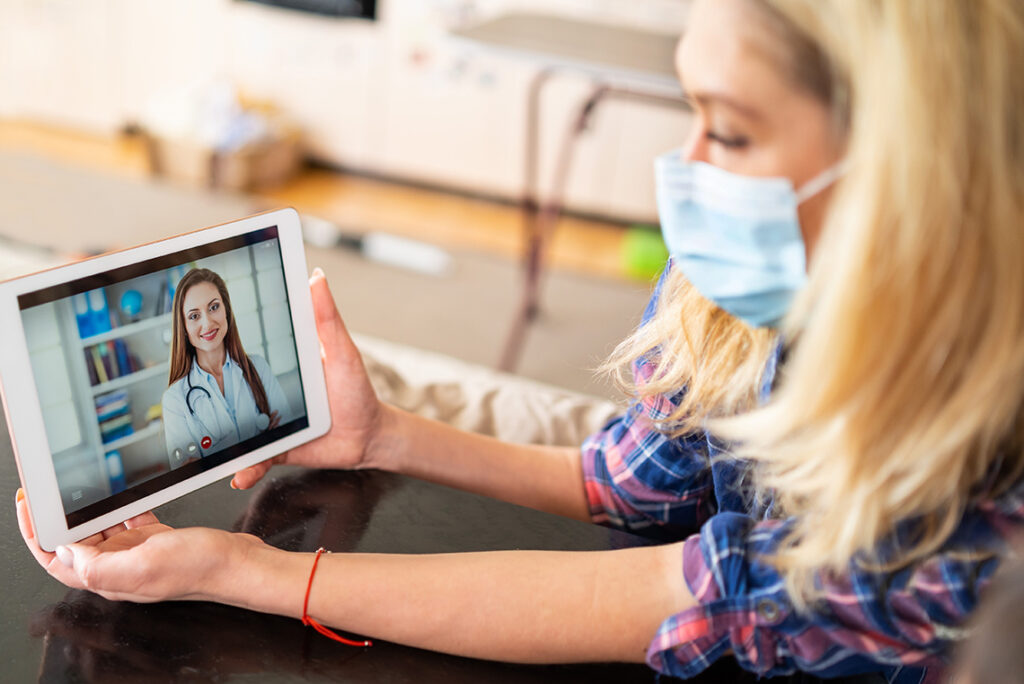Advancements in telehealth are on the rise as the pandemic puts strain on the traditional healthcare system; MedWand Solutions has revolutionized at-home care with their newest telemedicine kit.
 The MedWand device gives clinicians access to real-time data on their patients, allowing for an extensive exam from home while the clinician participates via video. The device can listen to the heart and lungs, scan skin, assess the tonsils, measure respiratory rates, and read blood oxygen levels.
The MedWand device gives clinicians access to real-time data on their patients, allowing for an extensive exam from home while the clinician participates via video. The device can listen to the heart and lungs, scan skin, assess the tonsils, measure respiratory rates, and read blood oxygen levels.
“MedWand has the ability to help save many lives and is easy to use. MedWand can help with triage, monitoring people in quarantine, and examining people for other conditions without bringing them into a potentially contaminated area,” said Samir Qamar, M.D., Co-Founder and CEO of MedWand Solutions.
While telehealth is not a new idea, the widespread adoption of the concept has been relatively slow. McKinsey & Company completed a COVID-19 consumer survey in April 2020 which reports, prior to the pandemic roughly 11 percent of US consumers were using telehealth. Post-pandemic, the number has skyrocketed to 46 percent of consumers using telemed appointments in place of those cancelled due to COVID-19 restrictions.
Telemedicine devices allow health care professionals to keep a safe distance from exposure, care for their patients, and reserve stock of personal protection equipment.
With innovation comes responsibility. Ensuring medical information remains private is not only imperative, but also the protection of a patient’s electronic personal health information (ePHI) is required by law. With digital patient records becoming the standard across the medical industry, assuring proper steps are being taken to safeguard their information is crucial.
McKinsey & Company COVID-19 Consumer Survey ( April 27, 2020) “76% of survey respondents indicated they were highly or moderately likely to use telehealth going forward.”*Shift from 11% in 2019*
While MedWand requires medical data be transmitted electronically, the company has taken steps to ensure ePHI will not be intercepted.
The device “has web-based software with military-grade encryption – we have the right tool at the right time, and we can deploy it fast,” said Dr. Qamar.
 This encryption software aids in adhering to the Health Insurance Portability and Accountability Act (HIPAA). Amid growing concern for protecting ePHI transmissions the HIPAA Security Rule stipulates only authorized users should have access to ePHI, a system of secure communication should be implemented to protect the integrity of ePHI, and a system of monitoring communications containing ePHI should be implemented to prevent accidental or malicious breaches.
This encryption software aids in adhering to the Health Insurance Portability and Accountability Act (HIPAA). Amid growing concern for protecting ePHI transmissions the HIPAA Security Rule stipulates only authorized users should have access to ePHI, a system of secure communication should be implemented to protect the integrity of ePHI, and a system of monitoring communications containing ePHI should be implemented to prevent accidental or malicious breaches.
With the security of patient information in mind, MedWand Solutions is tackling the increased need for real-time assessment of noncritical COVID-19 patients from home. Policy changes due to the pandemic have diminished obstacles and cleared the path for expedited approval from the Federal Drug Administration (FDA) for medical devices to be used in the US.
“MedWand has specific diagnostic instruments to remotely examine coronavirus patients, so we filed for an emergency use authorization with the FDA. We hope this will get approved quickly and should allow us to get these devices into the right hands, right away,” said Dr. Qamar.
The FDA outlines during a public health emergency, the administration can implement its Emergency Use Authorization (EUA) authority. This grants the use of unapproved medical products to diagnose, treat, or prevent serious or life-threatening diseases. Currently awaiting FDA approval, MedWand Solutions expects the device will be available to the US by early 2021.
THE FUTURE OF MEDICINE?
COVID-19 challenges traditional medical practices, revealing the growing need for alternative options. However, there are several barriers to the wide adoption of telehealth. For example, insurance coverage is a chief concern.
The American Hospital Association (AHA) reports roughly 15 percent of the population receives Medicare. Medicare has limitations on coverage and payment for many telehealth services, leaving a large portion of the elderly unable to use insurance to cover some telehealth appointments. The Medicare program has recently allowed payments to clinicians for virtual appointments, promising to take additional steps toward telehealth coverage in the future.
Further concerns regarding access to reliable broadband services affect the likelihood telehealth will become a permanent staple. Other issues to consider involve cross-state appointments, licensing, and how to provide proof of credentials to practice medicine.
While the exact role telehealth will play is uncertain, the necessity of innovations in medical equipment and access to healthcare goes without question.










